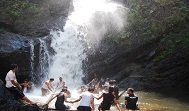 IRUPPU FALLS: the magnificent falls stands the famous Shiva temple Rameshwara along the banks of the river. Both the river stream and the temple have folklore behind their existences which have roots in the story of the epic Ramayana. The pristine cold water of the Iruppu falls is considered to be holy and possessing powers to clean the past sins of the visiting devotees. A major tourist attraction, the falls attracts a large number of tourists every year, especially during the festival of Navaratri. Located on a lush, green mountain slope, a forest trail leads from these falls to the Brahmagiri Peak. The best time to visit the falls is during the monsoons when they are at their full capacity and hence become a breathtaking sight to behold.
IRUPPU FALLS: the magnificent falls stands the famous Shiva temple Rameshwara along the banks of the river. Both the river stream and the temple have folklore behind their existences which have roots in the story of the epic Ramayana. The pristine cold water of the Iruppu falls is considered to be holy and possessing powers to clean the past sins of the visiting devotees. A major tourist attraction, the falls attracts a large number of tourists every year, especially during the festival of Navaratri. Located on a lush, green mountain slope, a forest trail leads from these falls to the Brahmagiri Peak. The best time to visit the falls is during the monsoons when they are at their full capacity and hence become a breathtaking sight to behold.
 NAGARAHOLE NATIONAL PARK: Nagarhole name has been derived from two Kannada name, Nagar means “snake” and hole meaning streams. Genuinely, the name strikes the true meaning to this national park where few serpentine streams fork through the rich tropical forests running eastwards through its center. The birth of Nagarhole National Parkcan be traced by the stretching area of 258 sq km when it was a hunting reserve for the Maharajas of Mysore. That time it included some of the areas of the forest like Arkeri, Hatgat and Nalkeriin Kodagu. Subsequently in the year 1974 some other reserve forests from the adjoining areas of Mysore district were added to bring the area as Nagarhole Game Reserve and then was updated into the national park extending by the area 643.39 sq km in the year 1988.The park was declared as a tiger reserve in the year 1999 to exemplify rich forest cover, small streams, hills, valleys and waterfalls. The park has a healthy tiger-predator ratio, with many tigers, Indian bison and elephants.
NAGARAHOLE NATIONAL PARK: Nagarhole name has been derived from two Kannada name, Nagar means “snake” and hole meaning streams. Genuinely, the name strikes the true meaning to this national park where few serpentine streams fork through the rich tropical forests running eastwards through its center. The birth of Nagarhole National Parkcan be traced by the stretching area of 258 sq km when it was a hunting reserve for the Maharajas of Mysore. That time it included some of the areas of the forest like Arkeri, Hatgat and Nalkeriin Kodagu. Subsequently in the year 1974 some other reserve forests from the adjoining areas of Mysore district were added to bring the area as Nagarhole Game Reserve and then was updated into the national park extending by the area 643.39 sq km in the year 1988.The park was declared as a tiger reserve in the year 1999 to exemplify rich forest cover, small streams, hills, valleys and waterfalls. The park has a healthy tiger-predator ratio, with many tigers, Indian bison and elephants.
